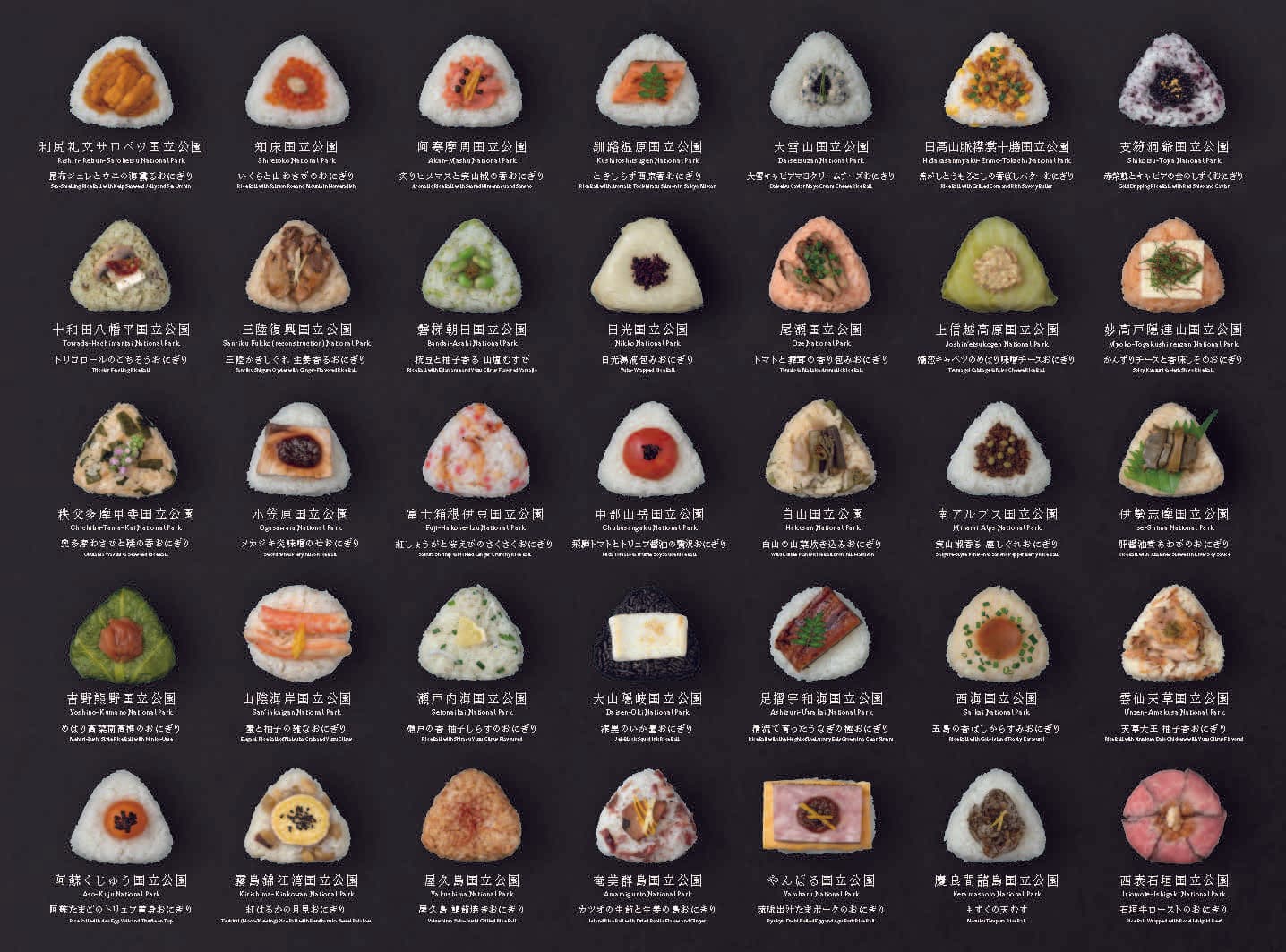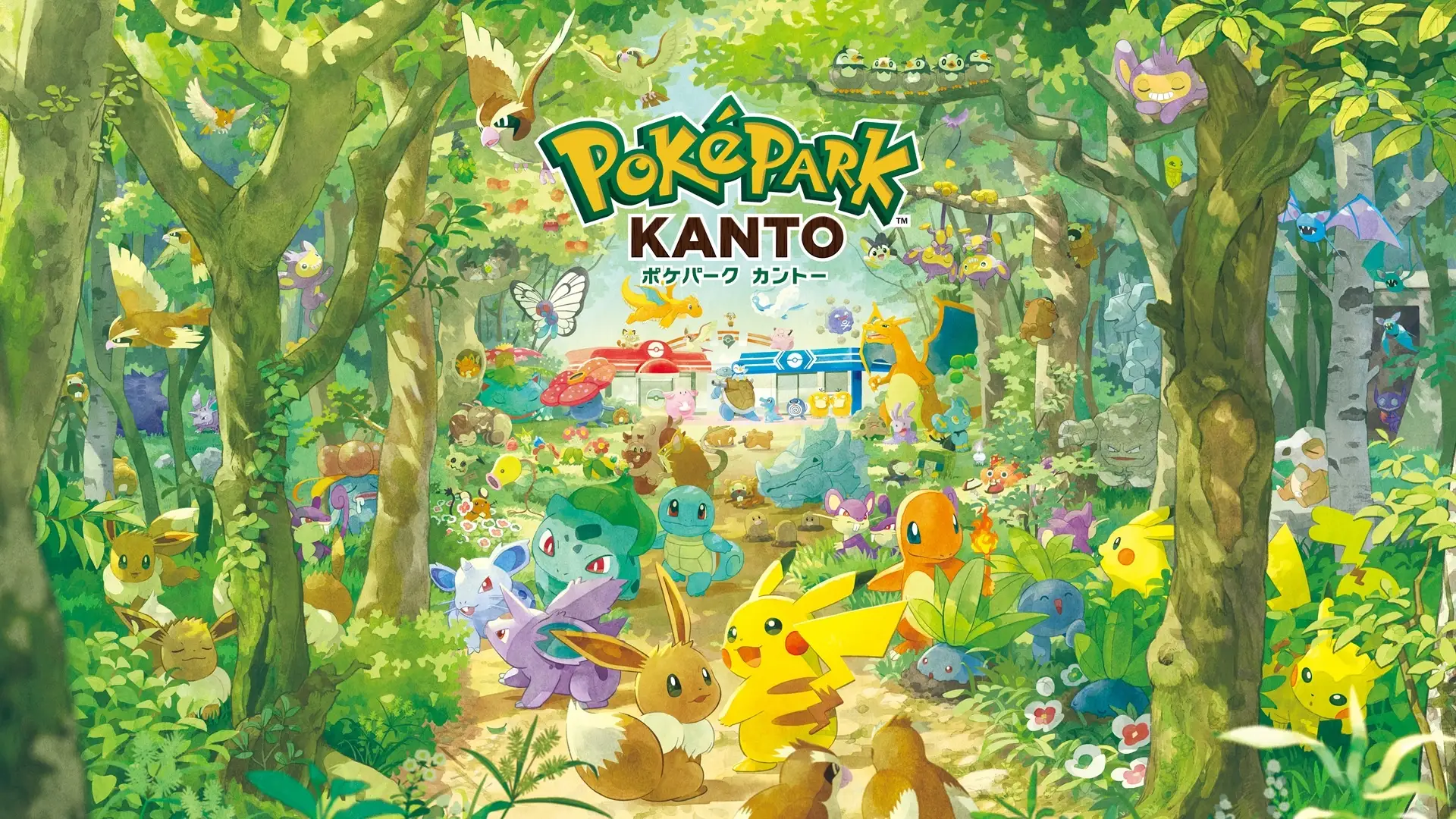
Monster Dissection Encyclopedia
Food often plays a key role in Japanese fiction, appearing prominently in novels, anime, manga, and video games. Stunning depictions of dishes can be found in works such as the Monster Hunter game franchise or the manga and anime Dungeon Meshi, which centers entirely on cooking fantastical ingredients.
In this context, Monster Dissection Encyclopedia -『モンスター解体図鑑』- offers a fascinating and unique perspective, combining fantasy monster lore with detailed, practical guidance on hunting, dissecting, and preparing creatures.
This fully illustrated manual blends encyclopedia and cookbook, presenting fantasy monsters with meticulous attention to detail. It provides comprehensive information on danger levels, ecology, and the unique properties of harvested materials, along with “delicious recipes” that make use of monster meat.
The encyclopedia is written by Shingo Itō, Professor in the Department of Japanese Language and Literature at Hirosaki Gakuin University. Professor Itō is renowned for his research on narrative literature, character culture, yōkai culture, and non-human characters. He has also authored other notable works in this genre, including “What If?” Illustrated Encyclopedia: How to Raise a Dragon -『「もしも?」の図鑑ドラゴンの飼い方』, and The Literary History of Personification and Battles Between Strange Beings - 『擬人化と異類合戦の文芸史』. The illustrations for Monster Dissection Encyclopedia are created by Miho Midorikawa, and the book is published by Kanzen Co., Ltd. It spans 160 pages and is currently available only in Japanese.
The encyclopedia serves as an excellent guide to monster knowledge, presenting well-structured information. Each chapter is dedicated to monsters of a specific danger level. According to the encyclopedia, “Danger Level E Monsters”are the weakest, the easiest creatures to deal with. The danger level increases up to “Danger Level A Monsters”, while the most formidable creatures belong to the “Danger Level S Monsters” category.

Table of Contents
Prologue – The Basics of Adventurers:
- Things You Can Do at the Adventurers’ Guild
- About Adventurer Ranks
- Uses of Collected Materials
- Why It’s Worth Butchering Yourself
- Tools Required for Dissection
- Pre-Butchering Preparations
Chapter 1 – Danger Level E Monsters:
- Slime
- Horn Rabbit
- Skeleton
Chapter 2 – Danger Level D Monsters:
- Poison Dot
- Killer Bee
- Giant Crab
Chapter 3 – Danger Level C Monsters:
- Cockatrice
- Kelpie
- Giant
- Scorpion
- Mandrake
Chapter 4 – Danger Level B Monsters:
- Basilisk
- Dire Bear
- Chimera
- Treant
Chapter 5 – Danger Level A Monsters:
- Golem
- Sahuagin
- Cerberus
Chapter 6 – Danger Level S Monsters:
- Kraken
- Cetus
- Leviathan
Column:
- Tips for Eating Monster Meat Safely
- Slime Subtypes
- Monster Poison Types
- Cockatrices are Dangerous Even from Their Eggs
- Plant-Type Monsters Can Be Used as Medicine
- Magic Stones Obtained from Monsters
- Recommended Items for Camping
- Edible Insects
A Glimpse of the Content
Each monster section offers detailed insights, including its size, magical attributes, ecology, notable traits and abilities, and methods for dissection. You’ll also discover which materials can be harvested, suggested recipes for their use, and even which body parts can serve as proof of having bested the creature - just in case you need to show evidence of your triumph.
Example: The Slime Entry
The encyclopedia suggests that slimes may be among the weakest monsters - they are classified as Danger Level E - but their materials have countless applications, making them far more valuable than their low danger level implies.
A slime’s body is composed almost entirely of water, and its magical attribute is naturally Water. They vary in size: small slimes can be around 30 cm tall and weigh only 2 kg, while larger specimens can reach 70 cm and 10 kg. Slimes will revive endlessly, much like undead monsters, unless their core is destroyed. To prove that a slime has been defeated, its core must be presented.
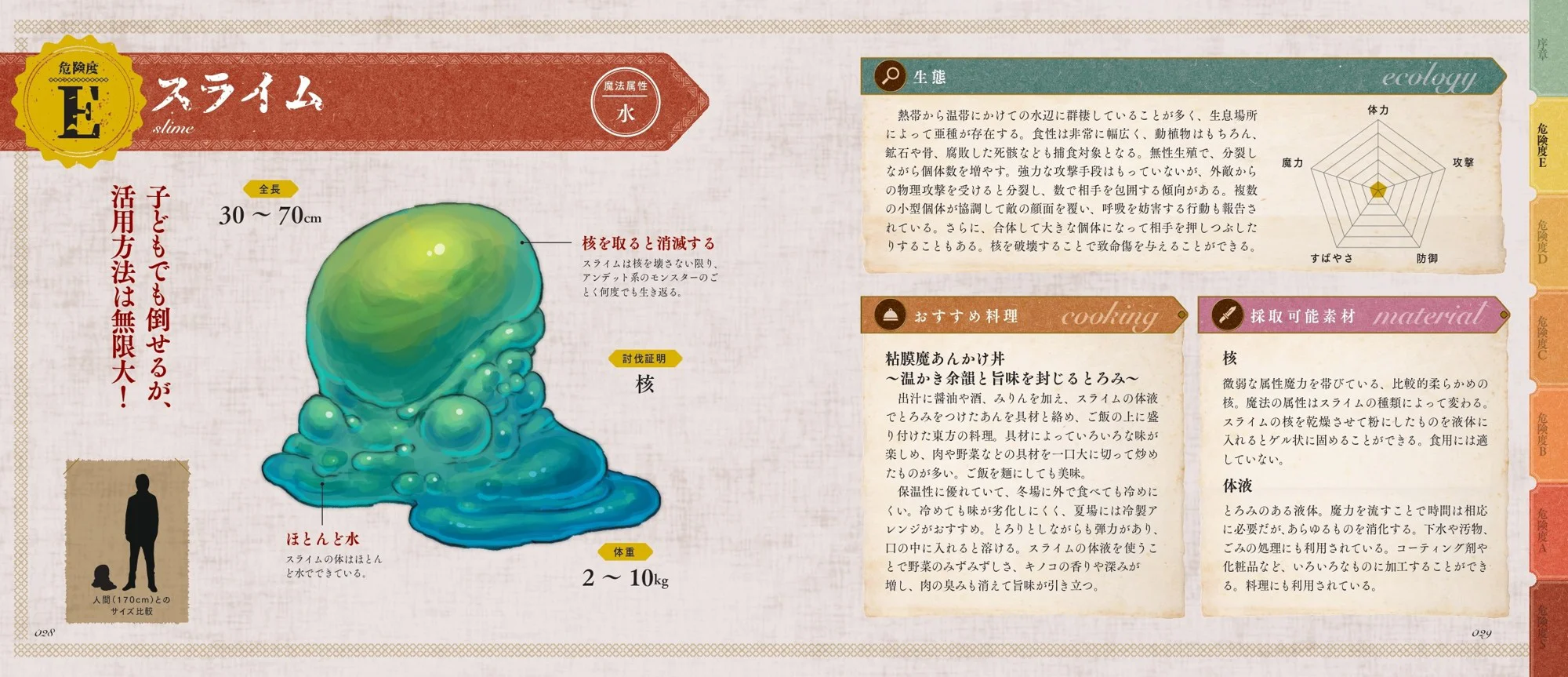
Ecology: Different subspecies exist depending on their habitat. Their diet is highly diverse, including plants, animals, minerals, bones, and even decaying corpses. Slimes reproduce asexually, multiplying through splitting. While a single slime is not particularly dangerous, when threatened it divides and surrounds its opponent in large numbers. Multiple smaller units have been observed coordinating to cover an enemy’s face, obstructing breathing. They can also merge into a larger form to crush targets. Fatal damage is inflicted by destroying the slime’s core.
Recommended Dish: Mucus Magic Slime Sauce - a silky sauce that locks in warmth and umami. Originating from the Eastern regions, this dish combines a broth with soy sauce, sake, and mirin, then thickened with slime bodily fluid to coat bite-sized ingredients such as meat, vegetables, or mushrooms, lightly stir-fried before adding the sauce. It can also be served over noodles instead of rice. The sauce retains heat well, making it ideal for outdoor winter dining, and maintains flavor even when cooled, making a chilled summer version appealing. Its thick yet elastic texture melts smoothly in the mouth. Using slime bodily fluid enhances the freshness of vegetables, deepens mushroom aromas, and neutralises any gaminess in meat, creating a rich umami taste.
Harvestable Materials:
- Core: A relatively soft core imbued with weak magical energy. Its properties vary by slime type. When dried and powdered, it can gel liquids but is not suitable for consumption.
- Bodily Fluid: A viscous liquid capable of digesting almost anything when combined with magical energy. Used in waste processing, coatings, cosmetics, and cooking.
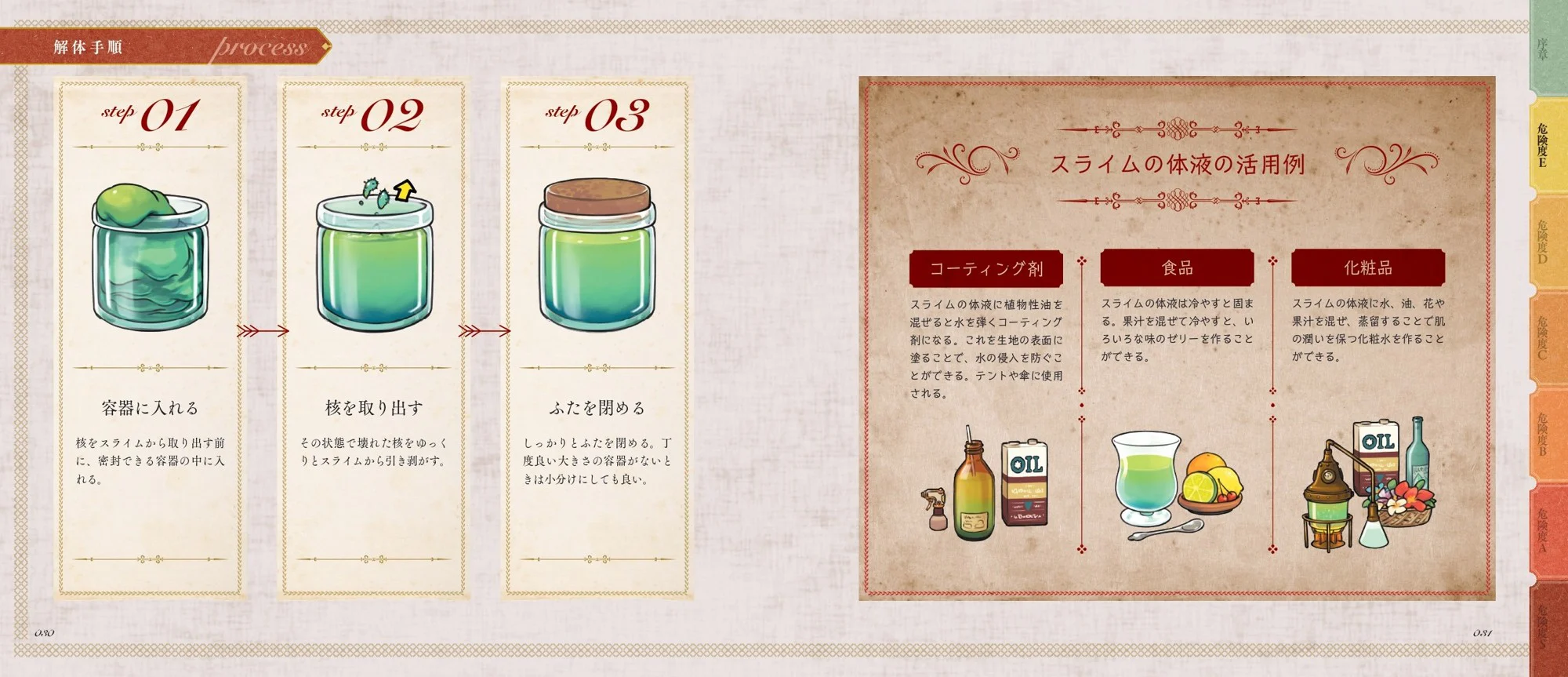
Dissection Procedure:
- Place in a Container: Put the slime into a sealable container before removing the core.
- Extract the Core: Carefully separate the broken core from the slime inside the container.
- Close the Lid: Securely close the container. If a suitably sized container is unavailable, divide the slime into smaller portions.
Uses for Slime Bodily Fluid:
- Coating Agent: Mixed with vegetable oil to create a water-repellent coating, ideal for tents and umbrellas.
- Food: Solidifies when chilled; mixed with fruit juice to produce flavoured jellies.
- Cosmetics: Combined with water, oils, and plant extracts or fruit juice, then distilled, it creates a moisturising lotion for the skin.
The slime is a relatively simple creature, and its dissection is straightforward. In contrast, the Horn Rabbit, also classified as a Danger Level E monster, is more complex than the slime.
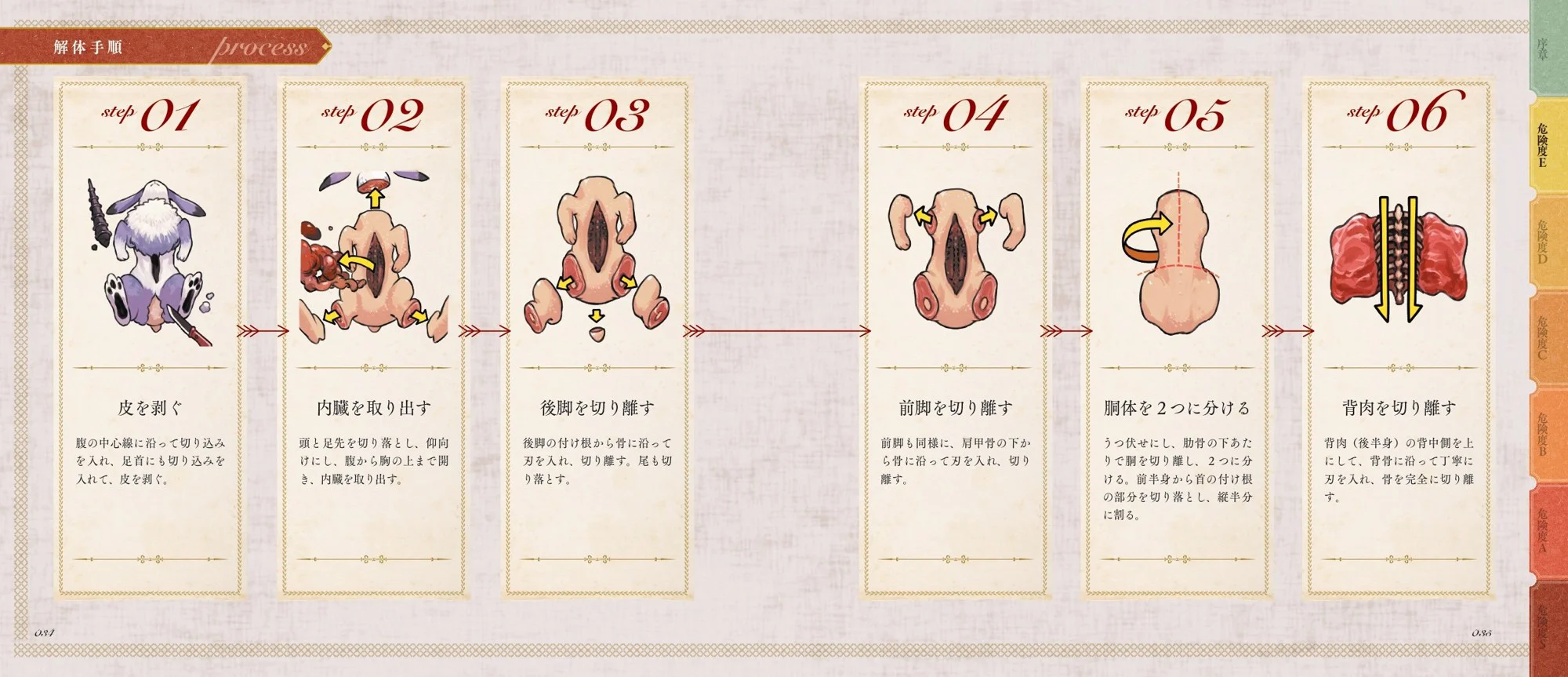
Dissection Tips
The encyclopedia offers a comprehensive guide to monster dissection, breaking it down into nine clear stages. Each step is explained with practical tips to ensure materials are harvested efficiently and without damage. Mastering these techniques is presented not just as a skill but as a path to true expertise - turning monster dissection into a profession of its own.
The Nine Steps of Dissection:
- Safety – Assign a lookout and choose a safe, open area.
- Cleaning – Wash away blood, mud, and dirt to prevent contamination.
- Suspension – Hang the body to allow easier access and avoid ground contact.
- Evisceration – Remove internal organs quickly and carefully to prevent decay.
- Skinning – Peel away the hide with precision to preserve material quality.
- Separation of Materials – Extract bones, horns, claws, and other parts without damage.
- Butchering – Divide the body into manageable sections, depending on species.
- Meat Processing – Cut and prepare meat while preserving texture and flavour.
- Aging – Store meat properly to enhance tenderness and umami.
This structured approach highlights just how thorough the encyclopedia is: it’s not only about monster lore, but also about teaching readers to think like professional hunters and harvesters.
Adventurers’ Guild
The encyclopedia also explains why you should consider joining an Adventurers’ Guild and what benefits membership offers.
The Adventurers’ Guild is more than a workplace - it is the heart of an adventurer’s life. Serving as both a hub and a base of operations, guild branches can be found in cities and along trade routes worldwide. Registered adventurers gather there daily to accept requests, defeat monsters, prevent disasters, and support the lives of local communities.
The guild’s core functions include mediating requests, purchasing harvested materials, registering and ranking adventurers, gathering and sharing information, and offering arbitration and emergency support. Because it maintains strict neutrality - independent of governments, nobles, or religions - the guild can operate across borders, ensuring that members may use branches in any region.
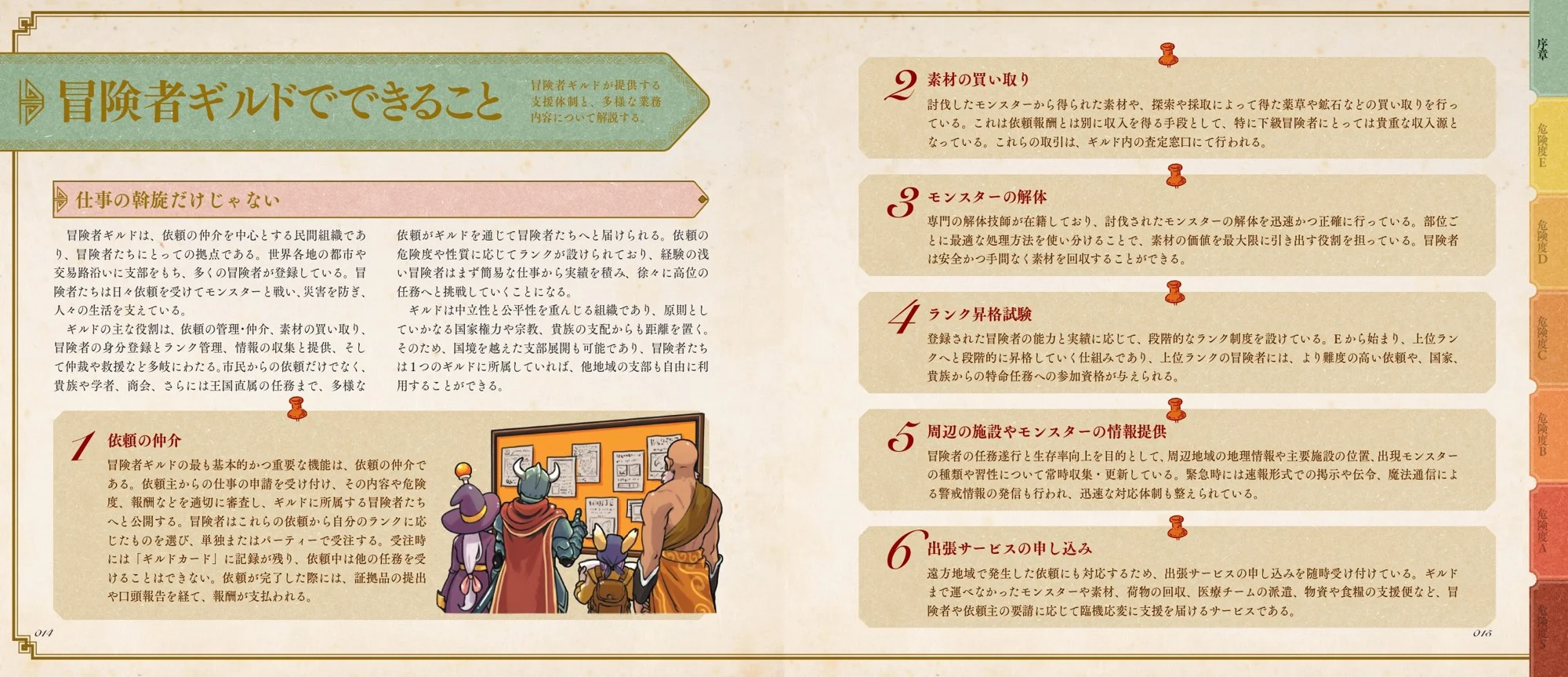
Main Services of the Guild:
- Request Mediation – The guild reviews and posts job requests, assigning danger levels and rewards. Adventurers select tasks appropriate to their rank, record them on their Guild Card, and must complete the mission before accepting another. Rewards are given upon proof of completion.
- Purchase of Materials – Monster parts, herbs, minerals, and other resources are appraised and bought directly by the guild, providing a steady source of income.
- Monster Dissection – Skilled technicians handle dismantling, ensuring maximum value from harvested materials without extra burden on adventurers.
- Rank Advancement Exams – Achievements and skills are evaluated through a rank system (from E upward), granting access to more challenging and prestigious missions.
- Information Services – The guild provides updated intelligence on geography, facilities, and monster behaviour. In emergencies, warnings and alerts are issued quickly to support survival and success.
- On-Site Services – For distant or urgent needs, the guild dispatches specialists for field dissection, medical support, material collection, or supply delivery.
Many practical tips are described in the column sections - knowledge that could even be life-saving for an adventurer.
This book could be of great value to adventurers, collectors, culinary professionals and enthusiasts, dissection specialists and beginners, or anyone simply curious about monsters and beautiful artwork.
The book is available for 2,310 JPY on KANZEN’s online shop, as well as on platforms such as Amazon Japan and Rakuten.
Last Updated:








